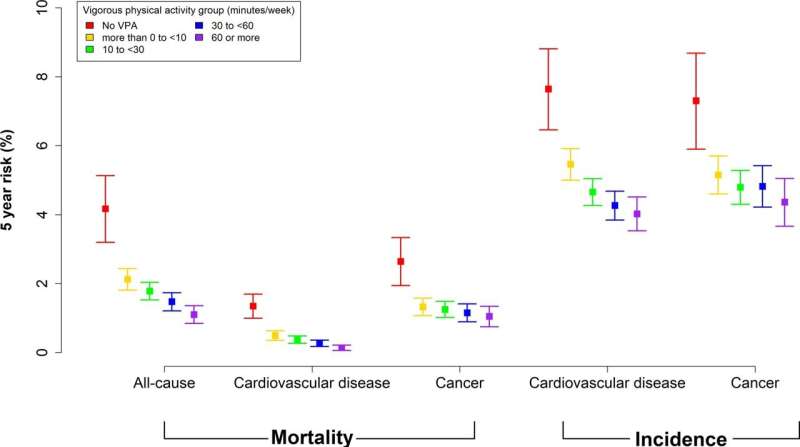Short bursts of vigorous activity linked with increased longevity

Two-minute bursts of vigorous activity totaling 15 minutes a week are associated with a reduced risk of death, according to research published today in European Heart Journal.
"The results indicate that accumulating vigorous activity in short bouts across the week can help us live longer," said study author Dr. Matthew N. Ahmadi of the University of Sydney, Australia. "Given that lack of time is the most commonly reported barrier to regular physical activity, accruing small amounts sporadically during the day may be a particularly attractive option for busy people."
A second study, also published today in EHJ, found that for a given amount of physical activity, increasing the intensity was associated with a reduced likelihood of cardiovascular disease. "Our study shows that it's not just the amount of activity, but also the intensity, that is important for cardiovascular health," said study author Dr. Paddy C. Dempsey of the University of Leicester and University of Cambridge, UK, and the Baker Heart and Diabetes Institute, Melbourne, Australia.
Both studies included adults aged 40 to 69 years from the UK Biobank. Participants wore an activity tracker on their wrist for seven consecutive days. This is an objective way to measure motion, and particularly sporadic activity of different intensities during the day.
The first study enrolled 71,893 adults without cardiovascular disease or cancer. The median age was 62.5 years and 56% were women. The investigators measured the total amount of weekly vigorous activity and the frequency of bouts lasting two minutes or less. Participants were followed for an average of 6.9 years. The investigators analyzed the associations of volume and frequency of vigorous activity with death (all-cause, cardiovascular disease and cancer) and incidence of cardiovascular disease and cancer after excluding events occurring in the first year.
The risk of all five adverse outcomes reduced as the volume and frequency of vigorous activity increased, with benefits seen even with small amounts. For example, participants with no vigorous activity had a 4% risk of dying within five years. Risk was halved to 2% with less than 10 minutes of weekly vigorous activity, and fell to 1% with 60 minutes or more.
Compared with just two minutes of vigorous activity per week, 15 minutes was associated with an 18% lower risk of death and a 15% lower likelihood of cardiovascular disease, while 12 minutes was associated with a 17% reduced risk of cancer. Further gains were observed with greater amounts of vigorous activity. For instance, approximately 53 minutes a week was associated with a 36% lower risk of death from any cause.
Regarding frequency, accumulating short bouts (up to two minutes) of vigorous activity on average four times a day was associated with a 27% lower risk of death. But health benefits were observed at even lower frequencies: 10 short bouts a week was associated with 16% and 17% lower risks of cardiovascular disease and cancer, respectively.
The second study included 88,412 adults free of cardiovascular disease. The average age was 62 years and 58% were women. The investigators estimated the volume and intensity of physical activity, then analyzed their associations with incident cardiovascular disease (ischemic heart disease or cerebrovascular disease). Participants were followed for a median 6.8 years.
The researchers found that both higher amounts and greater intensity were associated with lower rates of incident cardiovascular disease. Increasing the intensity led to greater reductions in cardiovascular disease for the same volume of exercise. For example, the rate of cardiovascular disease was 14% lower when moderate-to-vigorous activity accounted for 20% rather than 10% of activity, the equivalent of converting a 14 minute stroll into a brisk seven minute walk.
Dr. Dempsey said, "Our results suggest that increasing the total volume of physical activity is not the only way to reduce the likelihood of developing cardiovascular disease. Raising the intensity was also particularly important, while increasing both was optimal. This indicates that boosting the intensity of activities you already do is good for heart health. For example, picking up the pace on your daily walk to the bus stop or completing household chores more quickly."
More information: Matthew N Ahmadi et al, Vigorous physical activity, incident heart disease, and cancer: how little is enough?, European Heart Journal (2022). DOI: 10.1093/eurheartj/ehac572
Physical Activity Volume, Intensity and Incident Cardiovascular Disease, European Heart Journal (2022). DOI: 10.1093/eurheartj/ehac613




















